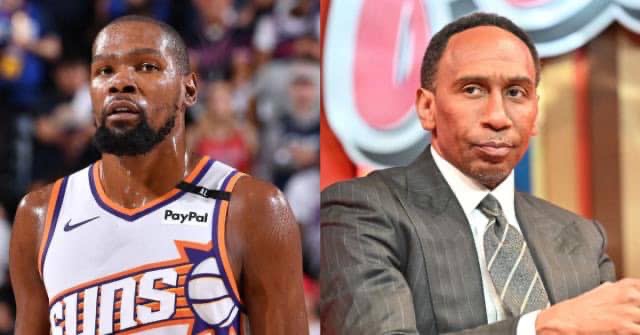Kevin Durant, the prolific scorer and one of the NBA’s most influential players, recently took aim at ESPN analyst Stephen A. Smith, igniting a firestorm of discussion both on and off social media. In a candid moment during a press conference, Durant expressed his frustrations with Smith’s commentary, labeling him a “clown” and questioning his credibility as a sports analyst. This public feud raises important questions about the relationship between athletes and media personalities, especially in the age of social media where opinions can quickly escalate into public disputes.
Durant’s comments came in response to a series of critical statements made by Smith regarding his performance and career decisions. Over the years, Smith has gained notoriety for his controversial opinions and his often fiery approach to sports commentary. His remarks about Durant—particularly in relation to his move from the Golden State Warriors to the Brooklyn Nets—have not always been favorable, which may have contributed to Durant’s frustrations.
During the press conference, Durant didn’t hold back, saying, “I’ve never seen him anywhere but on TV talking s— about players. … He’s a clown to me. He’s always been a clown. You can write that, too.” This direct attack not only underscores Durant’s disdain for Smith’s opinions but also reflects a broader sentiment among athletes who feel misrepresented or unfairly critiqued by media figures.
Durant’s outburst highlights a growing trend in the NBA and professional sports at large: athletes are increasingly vocal about their dissatisfaction with media coverage. The relationship between athletes and media has always been complex, with players often feeling that commentators lack a comprehensive understanding of the pressures and realities they face.
With the rise of social media, athletes like Durant have platforms to respond to criticism directly, bypassing traditional media outlets. This has led to more open dialogues, but it also opens the floodgates for public disputes that can escalate quickly. In this case, Durant’s criticism of Smith is not just a personal feud; it represents a broader challenge to the authority of sports commentators who may prioritize sensationalism over substance.
In today’s digital age, comments made during press conferences or interviews can go viral within moments, leading to immediate reactions from fans and commentators alike. Durant’s remarks about Smith have sparked a wave of responses from both supporters and detractors. Many fans appreciate Durant’s willingness to speak candidly, viewing it as a refreshing change from the typical, sanitized responses athletes often give.
Conversely, critics of Durant argue that his comments reflect a lack of accountability. Some believe that as a public figure, he should be prepared to handle criticism from those who analyze his performance. This dichotomy in viewpoints showcases the ongoing tension between athletes seeking to control their narratives and media personalities who strive to provide commentary based on their observations.
Stephen A. Smith has built a career on being provocative and controversial. His style has attracted millions of viewers, making him one of the most recognizable faces in sports media. However, this approach has also led to his share of critics, including players like Durant who feel he often crosses the line from analysis to personal attack.
Smith’s commentary has played a significant role in shaping public perception of athletes, often influencing how fans view players and their decisions. For instance, his criticism of Durant’s moves between teams often seemed to focus not just on basketball strategy but also on the implications of loyalty and competitiveness. This can lead to athletes feeling misunderstood or unfairly judged, which seems to be a significant factor in Durant’s recent comments.
As athletes continue to rise in visibility and influence, the traditional media landscape is evolving. The dynamic between players and commentators is likely to remain contentious as both sides navigate their roles in this new era. Players are increasingly seeking to establish their narratives, while commentators like Smith continue to fulfill their roles as analysts and critics.
Durant’s pointed remarks serve as a reminder that athletes are not just products of the media machine; they are individuals with their own voices and opinions. As the boundaries between athlete and commentator blur, it is essential for both parties to recognize the importance of mutual respect and understanding.
Kevin Durant’s candid critique of Stephen A. Smith encapsulates the ongoing challenges in the athlete-media relationship. As both sides grapple with their roles, the future promises to be as unpredictable as the game itself. The feud serves as a powerful reminder of the stakes involved when public figures interact, making it essential for both athletes and analysts to engage thoughtfully and respectfully in their discourse. As the NBA season approaches, fans will be watching closely to see how this dynamic unfolds and whether it will influence the way athletes and media personalities interact in the future.
